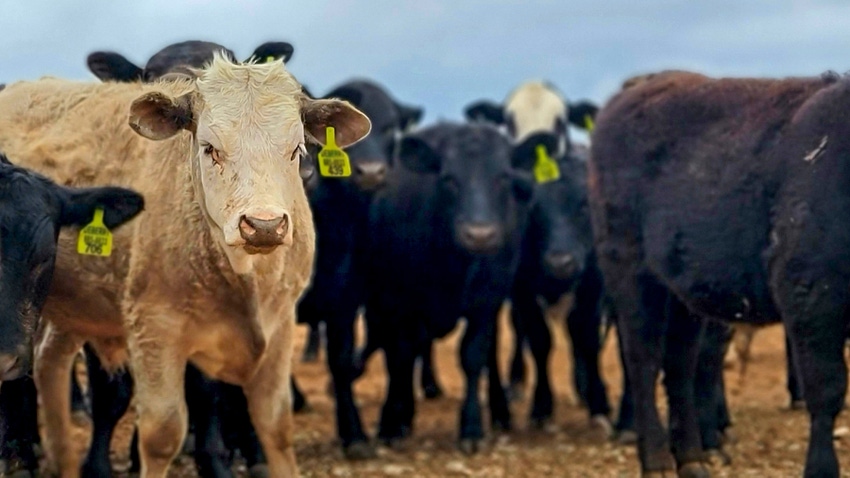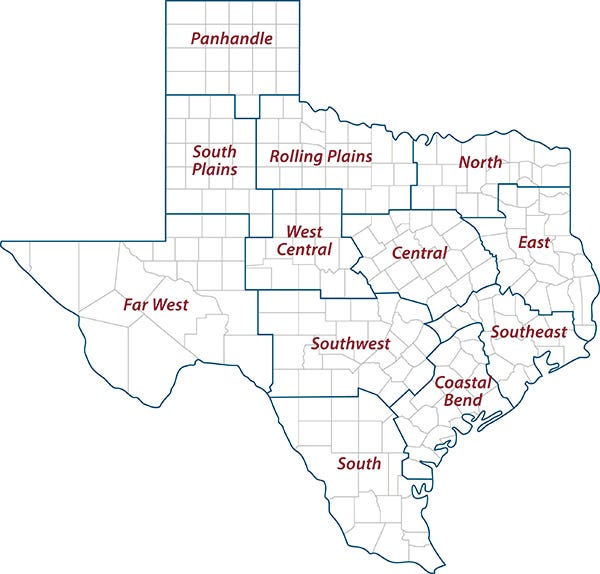
The Texas beef cattle herd could be on its way to a rebuild after hitting its lowest numbers in a decade, according to Texas A&M AgriLife Extension Service experts.
David Anderson, Ph.D., AgriLife Extension economist in the Department of Agricultural Economics, and Jason Cleere, Ph.D., AgriLife Extension statewide beef cattle specialist in the Department of Animal Science, both in the Texas A&M College of Agriculture and Life Sciences, Bryan-College Station, said Mother Nature will determine whether Texas’ beef cattle herd continues to shrink or rebounds. They agreed that rebuilding herd numbers will rely heavily on rain and soil moisture supporting forage production for grazing through 2024 and winter feeding into spring 2025.
According to the U.S. Department of Agriculture National Agricultural Statistics Service cattle inventory report released Jan. 31, the nation’s beef cow herd fell 2% since last year to 28.2 million head. Anderson said the report estimate is the lowest number of U.S. beef cows since 1951.
The beef cattle herd in Texas is the smallest – 4.1 million head – since 2014. The Texas herd started to recover from the 2011-2012 drought after that low point.
From 2010 to 2014, the Texas herd shrunk from 5.14 million to 3.9 million, a 24% decline, Anderson said. There were 4.65 million beef cows in 2019, but those numbers have fallen 12% since due to the drought’s impact on forage production in back-to-back years.
Declining beef cattle numbers across the state ripple into national markets because Texas carries 14.6% of the U.S. herd.
Like a big ship reversing course, Anderson said rebuilding cattle herds takes time.
“Higher sale prices are an incentive for producers to expand the herd, but a lot of producers have been feeding hay since mid-July, and that has led to deeper culling of herds,” Anderson said. “The stage is set to expand, but the key is rainfall and conditions allowing producers to hold back replacement heifers that are the future of our herds.”
Calf prices riding producer optimism
Cleere said recent rainfall has greatly improved soil moisture indexes and stock tank water levels around the state.
That soil moisture has fueled optimism among producers, and he suspects it has impacted recent spikes in calf prices at local cattle markets.
“I think producers are eager to keep replacement heifers, but they’ve also been struggling to hold on to cows,” Cleere said. “The rainfall has provided more optimism. Calf prices have been crazy good the last couple of weeks.”
For example, Anderson said the combined calf price data from Texas auctions showed prices for 500-600-pound calves increased from $273 to $299 per hundredweight in the last two weeks.
Cleere said the price jump in calf prices could be related to producers buying calves because they have good available grazing on cool-season forages like wheat and ryegrass. Recent rains should significantly improve spring forage production in cool-season forage pastures.
Good spring grazing conditions should help producers as calving begins, Cleere said.
The USDA-NASS report estimated the U.S. calf crop at 33.6 million head, down 2% from 2022. Cleere said Texas producers could see a lighter spring calving season due to factors like heat-related stress during the summer based on several palpitation reports around the state.
Cleere also shared concerns about seeing below-average body condition scores in bred cows. Low body condition scores could impact this calf crop but also could impact recovery times for breeding and cows’ ability to carry a calf to term.
While optimism is high among cattle producers now, Cleere said last year was an example of how quickly conditions can turn. There was optimism that the 2022 drought was breaking in parts of the state following winter and spring rain, but by May, the dry, hot conditions set in and did not let up.
He encouraged producers to find ways to optimize good conditions now but to stick to plans that protect their operation’s long-term ability to hold cattle. Both Cleere and Anderson agree that all market indicators point to even higher calf prices as the state and national herds rebuild.
“The big thing is, as we start spring calving, we need to make sure those cattle remain in good body condition so they can be bred,” he said. “I’ve seen quite a few thin cows out there, and I know producers are stretching hay supplies, but we need to be thinking about the next calf crop right now.”
AgriLife Extension district reporters compiled the following summaries:

CENTRAL
Although some regions of the district experienced rainfall, it hasn’t been widespread enough to bring the entire district out of drought. Some stock tanks were filling, but lake levels were still low. If lakes do not catch some significant rainfall by summer, there will be little to no irrigation this year. Warmer temperatures and good soil moisture were improving pastures and small grains. Winter pastures were starting to develop. Many producers had limited access to begin fieldwork in wet conditions, but they were getting planters ready for corn planting when the fields dried up. Wheat and oats were being grazed. Cattle producers were busy feeding hay and other supplements to maintain good body condition in their herd. Cattle prices were in good to fair condition, and calving season had started. There were reports that Hessian fly continued to be identified in some wheat fields.
ROLLING PLAINS
Unseasonable but much-welcomed mild temperatures dominated the district last week. A few counties were also able to report measurable precipitation. All producers would still like to receive more rain to maintain soil moisture levels and improve livestock drinking sources going into the spring. Wheat across the district maintained good condition, with no signs of rust reported. Cattle were also looking good, with some supplemental feeding being reduced slightly due to the growth of winter grasses in pasture and wheat after the amicable temperatures.
COASTAL BEND
Field activities were limited to lighter soil types, with grain producers preparing corn seeds for planting. Winter pastures were performing well, providing relief from hay feeding, while volunteer winter annuals greened up, offering high-quality forage for cattle. Recent rains replenished surface water supplies, but row crop activity was halted due to wet conditions. Additional rain over the weekend was expected to delay corn planting. Despite wet conditions, subsoil moisture was excellent, and pasture conditions were improving with increasing daylight and warming temperatures. Cattle remained in fair condition as producers continued feeding hay and protein.
EAST
Recent rains saturated many counties in the district. Pasture and rangeland conditions were fair to poor. Subsoil and topsoil conditions were surplus to adequate. Cattle markets across the district were strong, and prices were higher. Livestock were in fair to good condition, with supplementation taking place.
SOUTH PLAINS
With no rainfall last week, producers noticed that the subsoil moisture level was slightly more adequate than the topsoil moisture. Producers were prepping their fields for the coming planting season. Cattle were reported to be in good condition.
PANHANDLE
The region remained very dry. The weather modified, with some temperatures reaching the 70s but still no substantial moisture. Stocker cattle have been moved because of limited pasture. Supplemental feeding continued for cattle on pastures and rangelands. Overall, soil conditions were reported from adequate to very short. Pasture and rangelands were reported to be fair to very poor. Winter wheat was reported as fair to poor.
NORTH
Topsoil and subsoil were reported as adequate to surplus for all counties across the district. Pasture and rangelands were good to fair for most counties, with a few reporting poor conditions. Temperatures were warmer for the week, and some areas had rainfall up to 2 inches. These conditions allowed winter grasses to revive from the impact of the freeze in January. Some corn fields remained too wet to work. Wheat and oat conditions were poor due to previous harsh weather. Livestock were in good condition as hay feeding continued. Hay shortages in some areas impacted cattle inventory. Armyworms and cutworms were reported in Grayson and Fannin counties, but no other pest or disease were reported.
FAR WEST
Temperatures averaged highs of 70 with overnight lows in the upper 30s. The rain was in a narrow strip through the east-northeastern corner of the region. Tillage operations have continued for most growers this past week. Winter wheat was in fair condition due to moisture and warm weather. Underground moisture was non-existent. Many fields have yet to germinate. Many producers were questioning whether to turn irrigation wells on this season. Moisture improved minor grain conditions. Pecan harvest continued to be slower than anticipated, although most orchards were previously harvested. Ground preparation continued for the upcoming season; it’s anticipated acreage will be up due to the water supply from Elephant Butte Reservoir. Livestock were in fair condition. Lambing and kidding season began.
WEST CENTRAL
Rain fell over the district, allowing soil moisture to increase and be in good condition. The rain and warmer temperatures allowed small grain fields to improve. Wheat looked good and started creating good grazing for livestock. Rain was still needed to fill ponds for livestock water supplies. Although pastures and rangelands were greening up, producers continued heavy supplemental feeding for their herds. Cattle prices at local sale barns continued to rise, and cattle were holding good body condition.
SOUTHEAST
Heavy rain fell across multiple counties in the district, ranging from 2-8 inches; the heavy rain led to some areas flooding and the rivers and dams to peak, which could affect areas near the bayou. The saturated pastures and warm weather should produce an abundance of ryegrass and clover. Producers were preparing for corn planting, and the little wheat previously planted was doing well.
SOUTHWEST
Moisture conditions persist in some areas, thanks to ongoing rainfall. The rain has maintained favorable pasture and rangeland conditions, ensuring the well-being of livestock. The fall and winter rains have been crucial in sustaining producers’ operations for the past few months. With good soil moisture, livestock feeding activities were ongoing. However, despite the green appearance of pastures, they remain short. Producers began preparing their fields for spring planting, and the outlook for wheat and oats was positive. Nighttime temperatures were cold, while daytime highs reached the mid-70s. Producers faced challenges as they diligently searched for and paid more for hay. Producers were urged to stay vigilant and make strategic decisions in light of the weather conditions to ensure the sustainability of their operations.
SOUTH
From 1-9 inches of rain fell across the district. Topsoil and subsoil conditions remained adequate. Warmer temperatures allowed rangelands and pastures to grow, but cool nights slowed the growth. Farmers halted fieldwork due to the heavy rains. Crop conditions remained good. Certain counties were watching for fire weather since winds were gusting 35-40 mph last week. Livestock and deer producers continued to provide hay and supplementation to maintain body conditions. Cattle prices remain strong in the weaned calf and stocker beef categories.
About the Author(s)
You May Also Like




